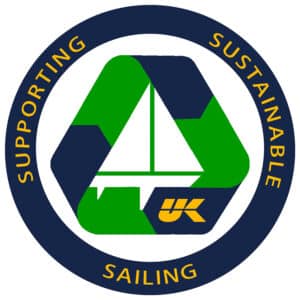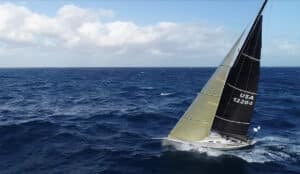Luffing before the starting signal is often mis-understood. Sailors should know that the rule makers give a lot of defensive and offensive powers to leeward boat on the starting line. That power comes from the following rules and definitions.
-
The definition of “Proper Course” states, “A boat has no proper course before her starting signal.” That means a right-of-way boat can alter course (within the limitations of Rule 16.1, see below), as long as she does not pass head-to-wind, because then she would be tacking.
-
Rule 11 says, “When boats are on the same tack and overlapped, the windward boat shall keep clear of the leeward boat.”
-
The definition of “Keep Clear” states, “A boat keeps clear of a right-of-way boat, (a) if the right-of-way boat can sail her course with no need to take avoiding action and, (b) when the boats are overlapped, if the right-of-way boat can also change course in both directions without immediately making contact.”
-
If a boat that was clear astern establishes an overlap to leeward, the windward boat has to keep clear and, if that means sail beyond head to wind to keep clear, it has too. The only limitations on the leeward boat are:
a. that she shall not sail above head-to-wind
b. that she complies with the limitations of Rule 16.1 which says: “When a right-of-way boat changes course, she shall give the other boat room to keep clear. The Rule Book defines the word “room” as, “The space a boat needs in the existing conditions, including space to comply with her obligations under the rules of Part 2 and rule 31, while maneuvering promptly in a seamanlike way.”
In America’s Cup and other match racing this is called “Getting the hook” on your competitor…good for the hooker, bad for the hookee! Therefore, on the starting line, someone needs to keep a lookout astern and to leeward for boats coming from astern, often this can be the leeward jib trimmer if you don’t have an extra tactician who can sit on the rail facing to leeward.
If a boat clear astern approaches in an attempt to get the hook and is yelling, “Come up, come up!”, remember that that boat must keep clear until an overlap is established and at that point she is subject to Rule 15 — When a boat acquires right of way, she shall initially give the other boat room to keep clear.
A boat clear ahead does not have to anticipate becoming a windward boat. The boat that was clear ahead does not become a give-way boat until an overlap is established. Only after the overlap is established does she have to alter course to keep clear. But don’t forget about Rule 16.1, the leeward boat has to give the windward boat room to keep clear. If the leeward boat gets so close when establishing the overlap that the windward boat makes contact when altering course in a seamanlike way, the windward boat was not given room to keep clear.
At the start of my race last week, I tacked to starboard to make my final approach to the line and one of my competitors tacked with me. He was overlapped to windward. I was about 5-10 seconds early and, since the line was skewed, the best way to burn time was to luff. I turned head-to-wind and the boat to windward kept clear. The next thing I heard was, “Protest. You made us sail beyond head to wind.” Knowing the rules. I responded that as the leeward boat that could luff head-to-wind and if he had to go beyond head-to-wind to keep clear, he was obligated to do that. He concurred and we both took off racing. Unfortunately, the wind dropped to zero halfway up the first leg and the race was abandoned. Even though the race didn’t count, it was still a good teaching experience.




What if the windward boat is at the RC end in this case? Some call this bargin, but that windward boat has not room to keep clear Is he/she obliged to luff up? What about Rule 2 (Fair Sailing) and avoiding collision and Rule 14 (Avoiding contact)? Seems to me that the leward boat should quit being a jerk and NOT create contact….while perhaps just quieting down and head to wind….this is right at the line with 5 seconds to go and he’d be over anyway if he kept weigh on. Any comments?
While I might sympathize with the windward boat’s predicament, this is the point of the article. I would call being in this situation a rookie mistake. If you are approaching the starboard end of the start line without a path available to match a leeward boat’s luff then you’d best plan for a two-turns penalty after you wiggle free of the trap you’ve set for yourself… Failure to respond and keep clear of the leeward boat is a violation, unless the luff comes so late that responding would cause a collision with the RC boat, which violates Rule 16.1
This defence is available to larger, less nimble boats, but harder to claim in a small dinghy or skiff. You have no right to room at a starting mark (though you can luff a windward boat to squeeze around the pin)
What if the windward boat is at the RC end in this case? Some call this bargin, but that windward boat has not room to keep clear Is he/she obliged to luff up? What about Rule 2 (Fair Sailing) and avoiding collision and Rule 14 (Avoiding contact)? Seems to me that the leward boat should quit being a jerk and NOT create contact….while perhaps just quieting down and head to wind….this is right at the line with 5 seconds to go and he’d be over anyway if he kept weigh on. Any comments?
While I might sympathize with the windward boat’s predicament, this is the point of the article. I would call being in this situation a rookie mistake. If you are approaching the starboard end of the start line without a path available to match a leeward boat’s luff then you’d best plan for a two-turns penalty after you wiggle free of the trap you’ve set for yourself… Failure to respond and keep clear of the leeward boat is a violation, unless the luff comes so late that responding would cause a collision with the RC boat, which violates Rule 16.1
This defence is available to larger, less nimble boats, but harder to claim in a small dinghy or skiff. You have no right to room at a starting mark (though you can luff a windward boat to squeeze around the pin)
Keep this up – it is good to share with crew et al !!!
Keep this up – it is good to share with crew et al !!!